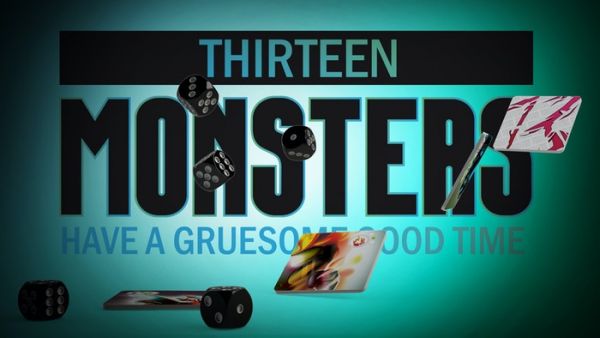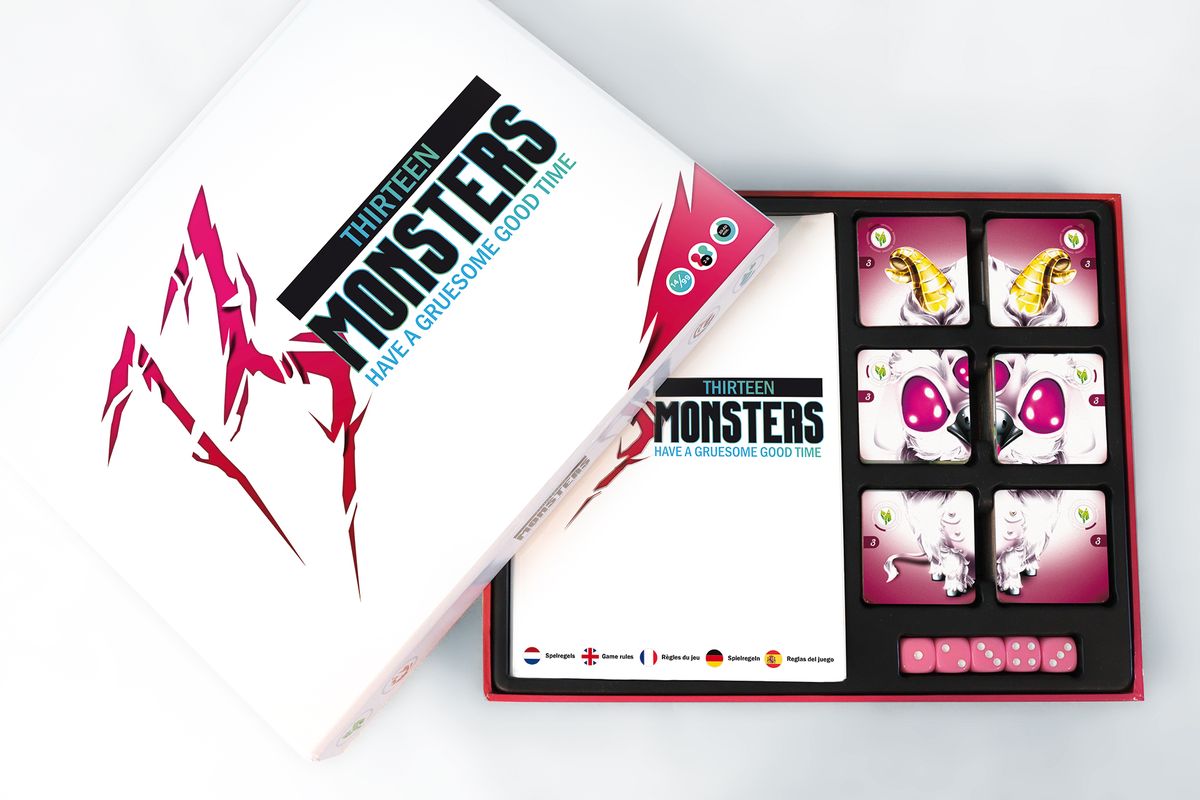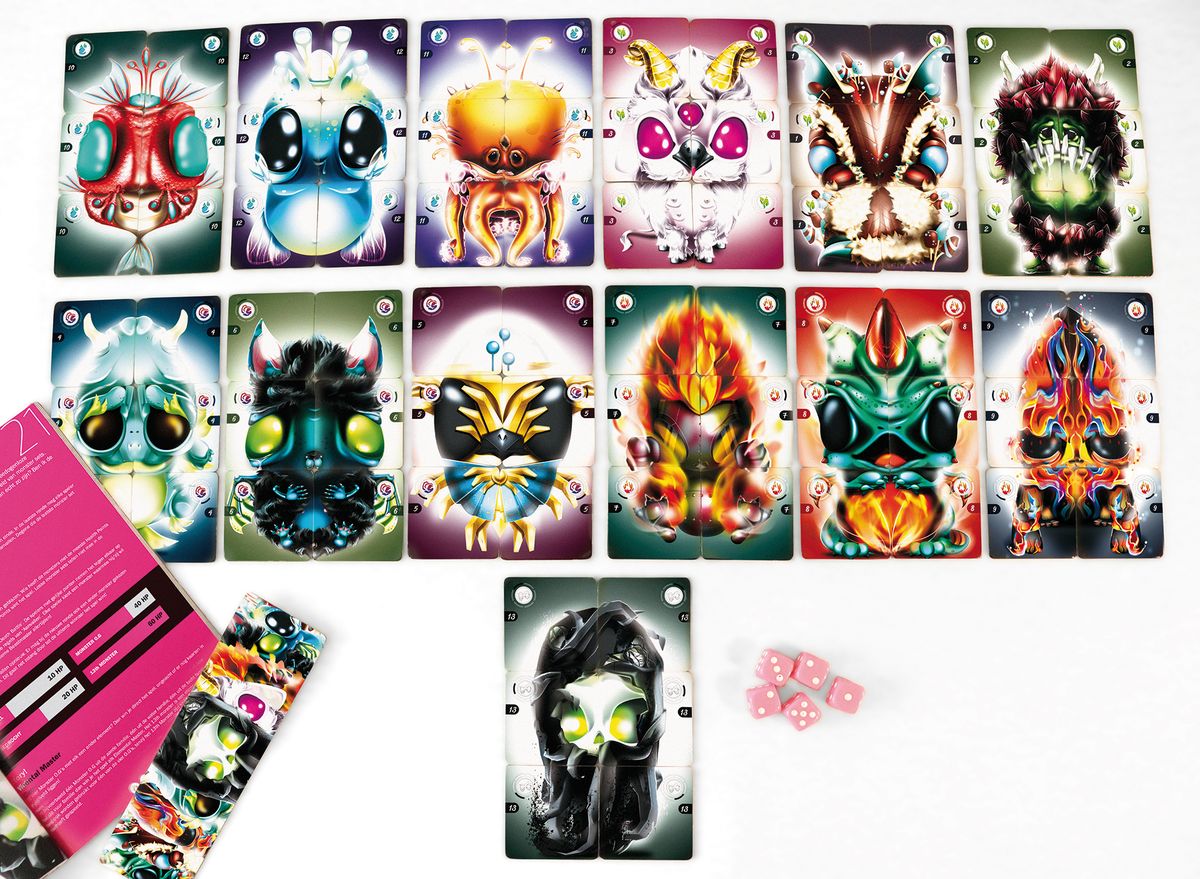Preview: Memory and Dice Combine for a Game of Beastly Battles in 13 Monsters

A unique combination of memory game and press-your-luck, dice-based combat, 13 Monsters is about building an assortment of monsters, stealing others from your opponents, and competing to become the ultimate beast master.
Already released in Europe, 13 Monsters is coming to the USA via Kickstarter, along with a brand new expansion.

Gameplay
All the tiles are laid out in a nine-by-nine grid, face-down, in the center of the table. Players are attempting to rise through three levels. During level one, on your turn you only have the search phase.
During the search phase, which you perform every turn regardless of your level, you flip over any two tiles in the center grid. If the two tiles form a set from the same monster, you collect the set and place it in front of you. Whenever you find a set during the search phase, your whole turn starts over again.
There are thirteen monsters in the game. Each monster consists of three tile sets: the head, the eyes, and the underside. Each monster shows one of four elements, and is also numbered one through thirteen, making it easier to identify when you have found a matching set.
Once you have at least one monster set, you move onto level two. At level two and three, before the search phase, you may offer to trade monster sets with other players. You are allowed to offer extra sets to make a trade more appealing.
As soon as you have a monster head, eyes, and underside you must build a monster. These three sets do not all have to belong to the same monster. Once you have built a monster you move onto level three where you can attack and use powers before the search phase.
The more sets in a built monster that belong to the same monster, the stronger that monster is. A monster whose three sets all belong to three different monsters is a Grunt and only has ten points of health and only has the sacrifice ability. A monster who has two matching sets is an Abomination, has twenty health points, and has the sacrifice and permafrost ability. A monster whose three sets all belong to the same monster is a Monster OG. It can perform both those abilities as well as the prophet power and has forty health points.
The sacrifice ability allows you to rearrange sets between your monsters. The permafrost ability allows you to place a die on a tile in the grid. This tile cannot be flipped over until you turn it over during your search phase or the next time any monster is attacked. The prophet ability allows you to turn over three tiles during your search phase.
The 13th Monster has a unique power called super nova, which allows you to take one of your opponent’s monsters for your own. You may only use this ability once and then the 13th Monster is out of the game and may no longer be used to attack nor be attacked (but it is still used to calculate your points at the end). The 13th Monster has sixty health points.
With the exception of permafrost, all powers and attacks must be performed before your search phase each turn. When attacking, you indicate a monster set of an opponent, and which one of your monsters is doing the attacking. If the set is not part of a completed monster your opponent will get as many rerolls as your attacking monster, otherwise they will calculate their number of rerolls based on the monster the set is a part of.
The attacker then takes the five dice and rolls them. Your monster gets three to five rerolls depending on the number of sets in your monster that belong to the same element group (the 13th Monster gets six rerolls). After your first roll you can set aside any dice that roll a matching number. On future rerolls you can set aside more dice that roll that same number; you can also choose to reroll all the dice including the ones you’ve set aside. After you finish your rerolls, you add up the total value of your set-aside dice. The defender then rolls in the same manner. The player with the higher total wins. If the attacker won, he claims the set he was attacking. If the defender won, she gets to choose a set from the attacking monster.
Once all the tiles have been claimed from the grid, everyone gets a final turn of using powers and attacking, and then the game ends. Players count up the total health points of all the built monsters they have, and the player with the highest total wins the game. Alternatively, if at any point in the game you have four Monster OGs that each belong to a different element, you automatically win the game. The 13th Monster can count as any of the four elements, but only if you have not used its super nova ability.

Expansion
In the Armed to the Teeth expansion, each time a player finds or captures a monster set, the blacksmith Thrall miniature moves to you. Whenever you have Thrall, you may use him to forge or steal. To forge, you roll the five special expansion dice, and depending on the number of anvils you roll you may draw an armor tile, a metal monster tile, or a weapon tile. To steal, you role the expansion dice against an opponent and if you roll more swords than they roll armor, you may steal from their armory (the armory is where you place any armor or weapon tiles that is not currently attached to a monster. You may only keep three tiles in your armory at a time).
Monsters can acquire additional abilities based on the number of armor tiles they are wearing, ranging from one which allows you to un-flip a tile during your search phase, to one that allows you to attack the 13th Monster after it has already gone super nova. Completed sets of armor are also worth ten points at the end of the game. Weapons and shields, meanwhile, give you additional bonuses for attack or defense, but have durability and will be discarded after a number of uses.
Metal monsters count as their own unique element towards victory. They have less health points than regular monsters but have special rules for attacking. A Grunt monster that is one part metal will win if they manage to roll and set aside five dice all showing the same number, regardless of the total of these dice, while Metal Abominations or a Metal Monster OG can set aside additional dice during the final roll in an attack regardless of whether their numbers match.

Review
13 Monsters is a unique combination of mechanics, with its memory tile flipping gameplay and the press-your-luck dice based attacks. These different elements work surprisingly well together and create an engaging experience with a balanced mix of luck, skill, and strategy.
While flipping tiles, you have a number of different factors to consider: what monster parts are you looking for and what do you already have, what tiles are you revealing to your opponents, and what elements have you already created. The ability to lock certain tiles away is also useful, and the fact that an attack will free these tiles up again, adds an extra layer to the decision making process.
The press-your-luck nature of the combat is also well done. You might have lots of threes after your first roll, should you set these aside? Or do you want to reroll everything in hopes of rolling some sixes? This combat also ensures that everyone always has a chance to win because even if you have half the rerolls of your opponent, you might just get really lucky.
Also the fact that a monster set not attached to a completed monster gets the same number of rerolls as the player attacking, helps build a little buffer into the gameplay if you start to fall behind. Players are more likely to leave you alone and focus on completed monsters, although they can still press their luck and attack if you have a set that’s particularly enticing to them.
All of this player interaction is really satisfying, with lots of sets going back and forth, and the trading adding just another layer. Players stay engaged even when it’s not their turn, particularly during the search phase, as you keep an eye on what tiles your opponents flip.
The components for the game are great. The artwork on the monsters is creative and detailed, and the tiles thick and glossy.
13 Monsters is a good fit for casual gamers, but there are a lot of small rules you have to learn, such as what each ability does or how many rerolls you get based on your monsters. There is a printed guide you can place on the table that does do a good job of summarizing most of this information, so you’re not constantly going back to the rulebook, but this will initially slow down the gameplay and make it run a little long. If you do find the game running longer than you’d like, the rules do suggest that each player can start with an already completed Grunt monster so that you can have the attack ability open to you right at the start.
Because of the initial learning curve, it’s best not to jump immediately into Armed to the Teeth while learning the game, as it brings its own extra set of rules and increases the complexity. We did like the additions it brought to the table, however, with weapons and swords giving you a way to minimize some of the luck of the roll, while durability ensures you can’t hide behind it forever.
The various equipment you acquire also makes the trading more interesting, with additional items to offer than merely monster sets.
13 Monsters is a creative mix of different mechanics, with plenty of player interaction, and we found the memory and the luck worked well together and resulted in a really fun game that didn’t feel quite like anything we’d played before. Check it out on Kickstarter, and prepare for some epic monster battles!
Pros: Excellent component quality, plenty of interesting choices, great player interaction
Cons: Learning curve slows down initial games, can run a little long
Disclosure: this preview is based on our evaluation of an unpublished prototype of the game, which is subject to change prior to publication. While a modest payment was received to expedite the review process, our thoughts and opinions expressed here are honest and accurate.




